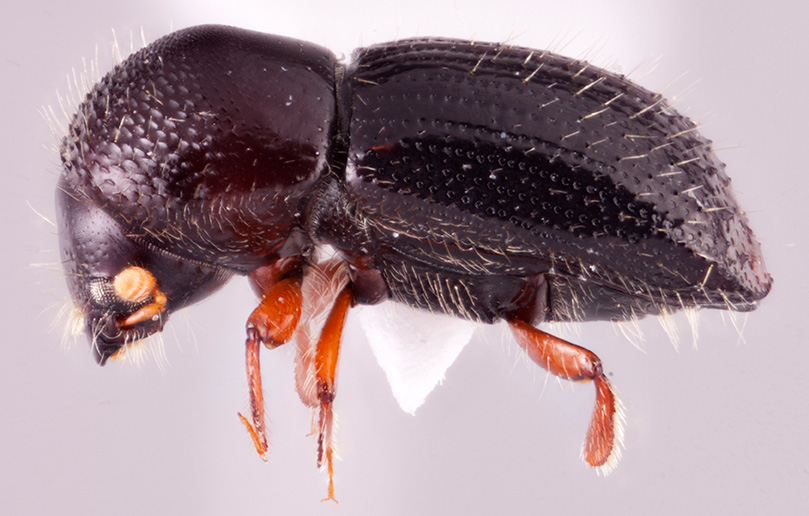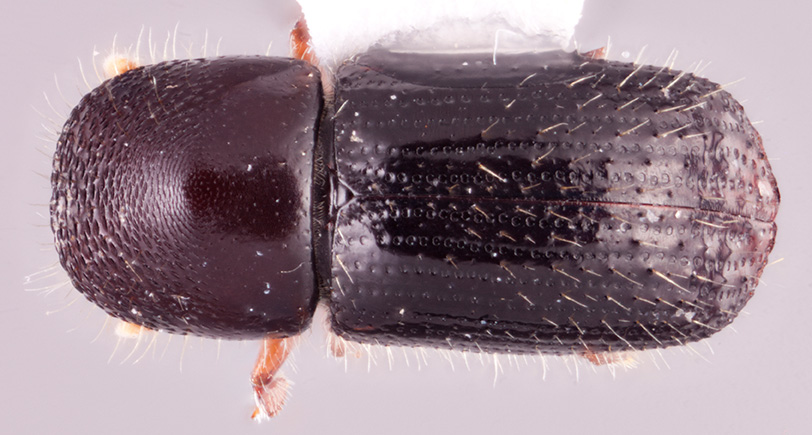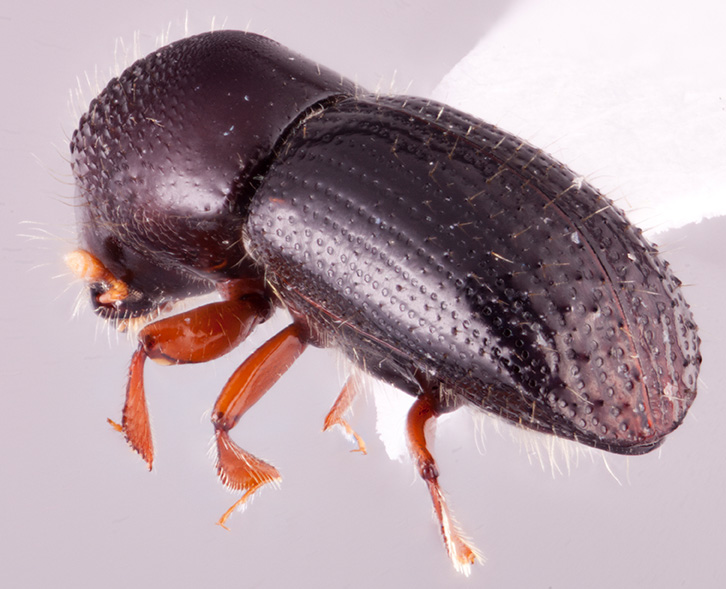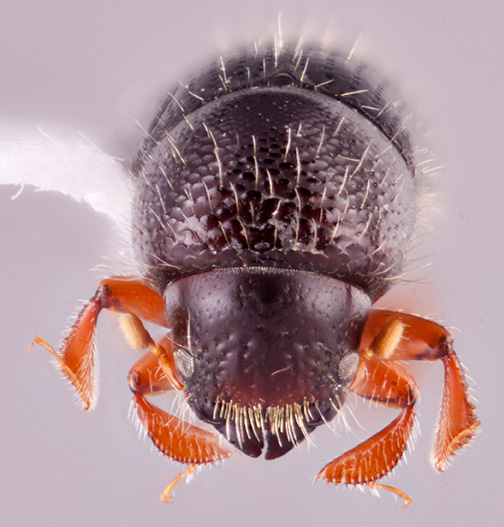Euwallacea validus
|
Euwallacea validus lateral; R.K. Osborn |
|
Euwallacea validus dorsal; R.K. Osborn |
|
Euwallacea validus declivity; R.K. Osborn |
|
Euwallacea validus frontal; R.K. Osborn |
Taxonomic history
Xyleborus validus Eichhoff, 1876a: 202.
Euwallacea validus (Eichhoff): Wood and Bright, 1992: 694.
Diagnosis
3.9−4.1 mm long (mean = 4.0 mm; n = 5); 2.50−2.73 times as long as wide. This species is distinguished by the pronotumpronotum:
the dorsal surface of the thorax
appearing subquadratesubquadrate:
almost quadrate, with oblique corners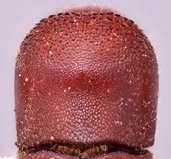 (type 3) from dorsaldorsal:
(type 3) from dorsaldorsal:
of or relating to the upper surface; opposite of ventral
 view; outer margin of protibiaeprotibia:
view; outer margin of protibiaeprotibia:
tibia of the first pair of legs
round; declivital interstriaeinterstria:
longitudinal spaces along the elytra between the striae, which is not as<br />
impressed and bear smaller punctures.
 1 granulategranulate:
1 granulategranulate:
pertaining to a coarse, grainy surface texture
 ; posterolateralposterolateral:
; posterolateralposterolateral:
relating to end of the side part/portion
 margin of declivitydeclivity:
margin of declivitydeclivity:
downward slope of either the pronotum or elytra
 carinate never granulategranulate:
carinate never granulategranulate:
pertaining to a coarse, grainy surface texture
 ; and moderately large size.
; and moderately large size.
It can be further separated from the strongly morphologically similar species E. interjectus by the declivitydeclivity:
downward slope of either the pronotum or elytra
 steeply sloped; declivitaldeclivital:
steeply sloped; declivitaldeclivital:
pertaining to the elytral declivity
strial punctures deep giving the declivitydeclivity:
downward slope of either the pronotum or elytra
 a rugged appearance; and tuberclestubercle:
a rugged appearance; and tuberclestubercle:
a small knob-like or rounded protuberance of the exoskeleton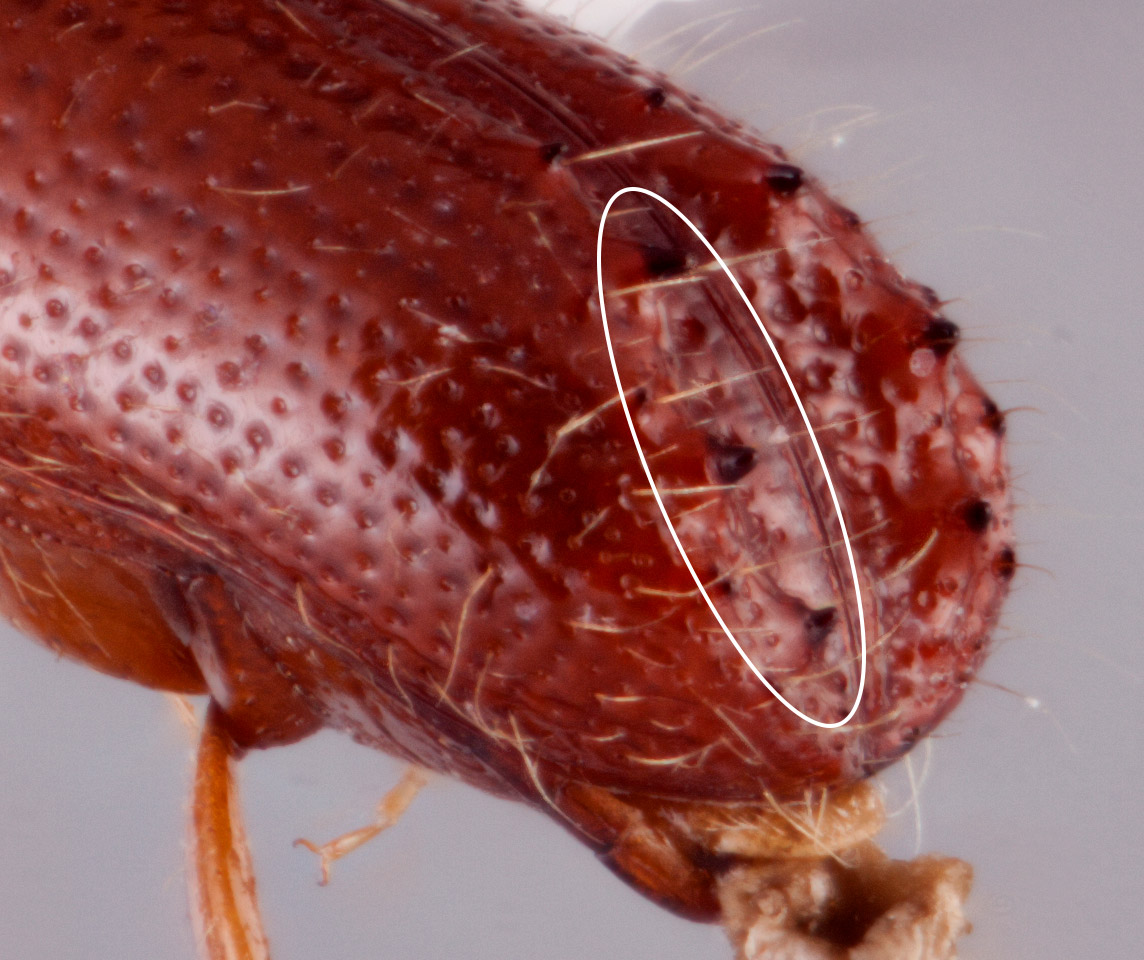 mostly absent from the apicalapex:
mostly absent from the apicalapex:
point or edge furthest from the body; opposite of base
 half of interstriaeinterstria:
half of interstriaeinterstria:
longitudinal spaces along the elytra between the striae, which is not as<br />
impressed and bear smaller punctures.
 2.
2.
May be confused with
Euwallacea funereus, E. interjectus, and E. velatus
Distribution
China (Anhui, Chongqing, Fujian, Hubei, Yunnan), Japan, South Korea, Nepal, Taiwan, Vietnam; introduced and established in USA (Wood 1975, Cognato et al. 2015Cognato et al. 2015:
Cognato AI, Hoebeke ER, Kajimura H, Smith SM. 2015. History of the exotic ambrosia beetles Euwallacea interjectus and Euwallacea validus (Coleoptera: Curculionidae: Xyleborini) in the United States. Journal of Economic Entomology 108: 1129-1135. https://doi.org/10.1093/jee/tov073, Gomez et al. 2018aGomez et al. 2018a:
Gomez DF, Rabaglia RJ, Fairbanks KEO, Hulcr J. 2018a. North American Xyleborini north of Mexico: a review and key to genera and species (Coleoptera, Curculionidae, Scolytinae). ZooKeys 768: 19-68. https://doi.org/10.3897/zookeys.768.24697) and Europe (France) (Dodelin 2023Dodelin 2023:
Dodelin B (2023) Euwallacea validus (Eichhoff, 1876) nouveau scolyte pour l’Europe. https://entomodata.wordpress.com/2023/11/30/euwallacea-validus-eichhoff-1876-nouveau-scolyte-pour-leurope/)
Host plants
polyphagous, attacking both gymnosperm and angiosperm trees (Wood and Bright 1992Wood and Bright 1992:
Wood SL, Bright DE. 1992. A catalog of Scolytidae and Platypodidae (Coleoptera), Part 2: Taxonomic index. The Great Basin Naturalist Memoirs 13: 1-1533.)
DNA data
Sequences available for COI and CAD.
Additional COI sequences from across Asian and North Ameircan populations are given in Cognato et al. 2015Cognato et al. 2015:
Cognato AI, Hoebeke ER, Kajimura H, Smith SM. 2015. History of the exotic ambrosia beetles Euwallacea interjectus and Euwallacea validus (Coleoptera: Curculionidae: Xyleborini) in the United States. Journal of Economic Entomology 108: 1129-1135. https://doi.org/10.1093/jee/tov073.

